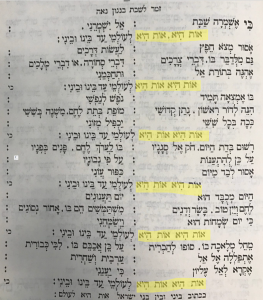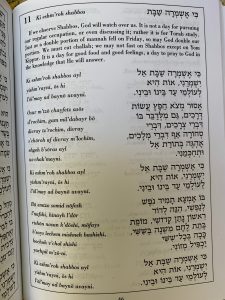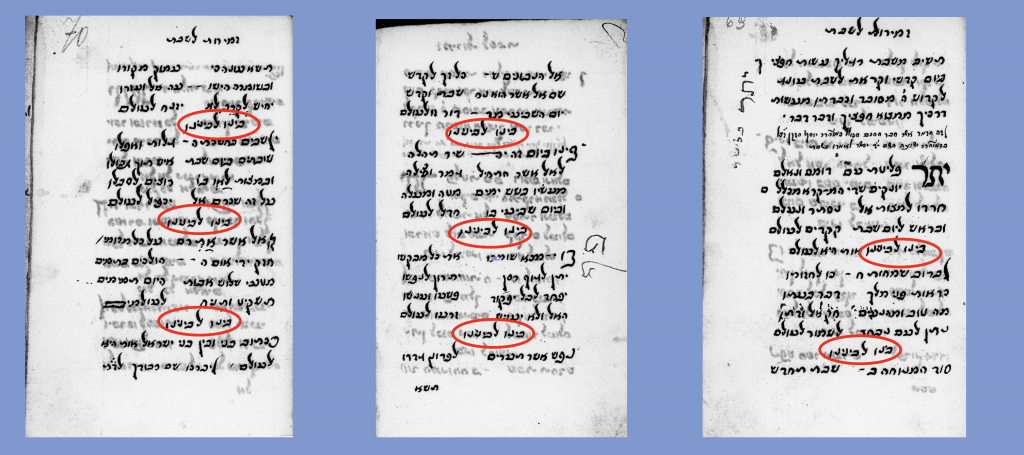“The first step is the two-step,” sang the incomparable country musician Tracy Byrd. But Country music has nothing on the Turkish Two-Step (as I have dubbed it) and its apparent incorporation into Karaite poetry.
As I was reviewing some poetry for an upcoming birkon, I noticed that many poems printed in Karaite siddurim repeated the first two syllables of the chorus. As I was investigating why, I recalled the time I totally choked on singing the Karaite melody of Ki Eshmera Shabbat.
About 7 years ago, I was having Shabbat dinner at the house of a couple I had met through the Mission Minyan. As they were about to sing Ki Eshmera Shabbat, I mentioned that the Egyptian Karaite melody was markedly different from the one they usually sang. So they asked me to sing it. I obliged, and I looked down at the poem and saw that it was laid out a bit differently from what I was used to, and I couldn’t translate the melody in my head to match what was written down.
And I faltered. That could have been my big break. . . .
See here is what is in the Vilna Karaite Prayer book (Vol. 4):
And here is something resembling the printing of Ki Eshmera Shabbat I saw that night I faltered.
In addition to having a totally different format, you will see that the words Ot Hi (in the chorus) are printed twice in the Karaite printing (highlighted in yellow) and once in the Rabbanite version. (As an aside, I wrote previously how Ki Eshmera Shabbat is an anti-Karaite polemic.)
I never thought about this repetition in the chorus again until just recently, when working on this birkon and I saw this repetition over and over in the songs selected for inclusion.
You may not have noticed it, but there are two Karaite songs online that have this repetition.
One song is “Yeter Peletat ‘Am” – which repeats the word Beno chorus.
The other song is Mizmor Leyom Toda, which I wrote about here. This song repeats the word ‘Ala in the chorus.
The important thing to note is that this repetition actually breaks the poem’s meter – so scholars have gone to lengths to try to explain the reason for the doubling. (I’m not going to get into a discussion of the meter in this article, but I might do a class on it in the future.)
As I’ve mentioned previously, Dr. Riikka Tuori took the lead in helping select and translate poems for the upcoming birkon, and how she is an absolute expert on the Karaite Piyyutim in Volume 4 of the Vilna siddur. So I took a peek at her dissertation (THANK YOU, RIKKA) and she addresses this phenomenon.
Scholars give a few reasons for why these poems are printed with a repeated first two syllables of the chorus.
- Identifying the Melody: some have argued that the first two syllables are repeated and printed twice to reflect that the song is to be sung (or may be sung) according to the melody used for Ki Eshmera Shabbat, which is written in the same meter and has the same repetition (in the Karaite printing).
- Intensifying the Meaning: some have argued that the purpose of repeating the first two syllables of the chorus is an poetic flourish in which the poet intentionally breaks the meter in order to emphasize this line.
- The Turkish Two-Step: Yet others suggest that this was due to influence from Turkish music, which apparently had this sort of repetition, and Karaite writers familiar with Turkic languages and poetry wrote poems with this repetition.
Note that numbers 1 and 3 are not mutually exclusive. The doubling could have originated from Turkish influences (i.e., #3) and it could be printed in so many poems to suggest that the poem be read according to a well-known melody.
If the purpose of this is repetition is to intensify the meaning, then we would expect this to be apparent in older manuscripts and indeed in older printings of these poems. In fact, though, according to Dr. Tuori’s dissertation, this doubling of the first two syllables is absent from earlier Polish Lithuanian manuscripts and is absent from Karaite Siddur printed in Chufut-Kale in 1737.
This repetition is also markedly absent from earlier, handwritten siddurim. For example, the first song above Yeter Peletat Am, appears in a handwritten siddur as such – with no repetition. I’ve circled the relevant place in the chorus and you can see it says “Beno Levenenu” not “Beno / Beno Levenenu”
It just so happens that the text upon which the Karaite community in Israel based its version of Mizmor Leyom Toda, actually does have this doubling in the first iteration of the chorus, but not in the subsequent iterations.
By the way, I confess that even after I learned about this doubling and even after I had heard this Mizmor Leyom Todah 100 bagillion times, I still didn’t realize at all that it was an example of this repetition until I saw this image above.
Sadly, I don’t have any special insight into the actual reason for the doubling. I do think we can rule out any “poetic” explanations – meaning, given the lack of doubling in earlier sources, it seems unlikely that this was done by the poet to intensify the meaning. I also think we could probably rule out anything indicating a specific melody for the poem, otherwise there’d be many poems with the same melody. That’s seems pretty boring. And Karaite poetry is not boring. (Actually, more reasonably, there are many poems in the Karaite Vilna siddur written in the same meter, but without the doubling. So it would seem strange that *some* are identified to be sung to the same melody but others are not.)
I do think – if I had to guess – that the explanation that this was due to influence of Turkish music is plausible – especially given how prominent the Karaite community used to be in Turkey.
Anyway, happy listening and I cannot wait to share more songs from the upcoming birkon with you.
In the meantime, just for fun, go ahead and sing Mizmor Leyom Toda to the tune of Yeter Peletat Am or the tune of any version of Ki Eshmera Shabbat you know.








very interesting – do yu have any idea what proportion of the mediaeval Karaites were from Rabbinic backgrounds? NAd were there groups that had been non rabbinic since Temple times?
We actually have no verifiable sources that any of the karaite *leaders* were from rabbanite families. We know of individuals but no leadership.
Shalom, Shawn!
I agree with you that this doubling is probably due to Turkish influence.
But regardless what this detail can mean, these poems are so beautiful!
Thank you for your efforts to publishing them!